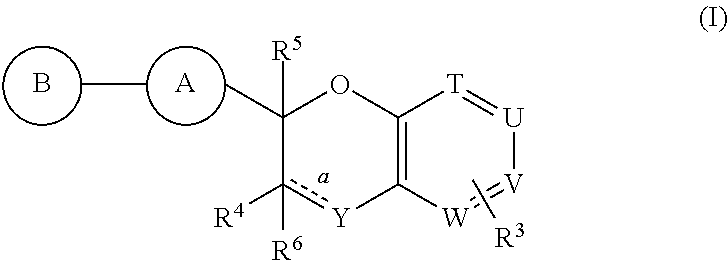Antidiabetic heterocyclic compounds
- Summary
- Abstract
- Description
- Claims
- Application Information
AI Technical Summary
Benefits of technology
Problems solved by technology
Method used
Image
Examples
example 1
(2S,3R)-3-cyclopropyl-2-methyl-3-((R or S)-2-(2-(3-(trifluoro-methyl)pyridin-2-yl)-2-azaspiro[3.3]heptan-6-yl)chroman-7-yl)propanoic Acid
[0542]
Step A: tert-butyl 6-(methoymethylene)-2-azaspiro[3.3]heptane-2-carboxylate
[0543]To a solution of (methoxymethyl)triphenylphosphonium chloride (2.92 g, 8.52 mmol) in THF (20 mL) was added dropwise LDA (4.47 ml, 8.95 mmol, 1.0 M in THF) over 20 min under N2 at 0° C. The reaction mixture was stirred at room temperature for 2 h. Then a solution of tert-butyl 6-oxo-2-azaspiro[3.3]heptane-2-carboxylate (900 mg, 4.26 mmol) in THF (10 mL) was added dropwise to the mixture. The reaction mixture was stirred at 60° C. for 3 h, then quenched with water (30 mL) and extracted with ethyl acetate (20 mL×3). The combined organic layers were washed with water (40 mL) and brine (40 mL), dried over anhydrous MgSO4 and filtered. The filtrate was concentrated under reduced pressure. The resulting residue was purified by column chromatography on silica gel eluted ...
example 2
(2S,3R)-3-cyclopropyl-2-methyl-3-((R or S)-2-(2-(3-(trifluoromethyl)pyridin-2-yl)-2-azaspiro[3.3]heptan-6-yl)chroman-7-yl)propanoic Acid
[0554]The second peak obtained in Example 1 Step I was prepared in the same way as described for the first peak to afford the title compound, the diastereomer of Example 1. MS (ESI) m / z: 501.2 [M+H]+ 1H NMR (400 MHz, CDCl3): δ=8.33 (d, J=4.0 Hz, 1H), 7.74 (d, J=7.6 Hz, 1H), 6.98 (d, J=7.6 Hz, 1H), 6.82 (s, 1H), 6.65-6.60 (m, 3H), 4.33 (d, J=9.6 Hz, 1H), 4.23-4.20 (m, 3H), 4.03 (d, J=10.8 Hz, 1H), 2.87-2.71 (m, 3H), 2.43-2.25 (m, 5H), 1.95-1.67 (m, 3H), 1.26-1.22 (m, 1H), 1.19 (d, J=8.0 Hz, 1H), 0.70-0.66 (m, 1H), 0.41-0.38 (m, 2H), 0.07-0.03 (m, 1H).
example 3 and example 4
(2S,3R)-3-(2-((1R,5S)-7-((R)-1-(2,5-bis(trifluoromethyl)phenyl)ethyl)-3-oxa-7-azabicyclo[3.3.1]nonan-9-yl)chroman-7-yl)-3-cyclopropyl-2-methylpropanoic Acid
[0555]
Step A: (2S,3R)-methyl 3-(2-((1R 5S)-3-oxa-7-azabicyclo[3.3.1]nonan-9-yl)-chroman-7-yl)-3-cyclopropyl-2-methylpropanoate
[0556]To a solution of (1R,5S)-tert-butyl 9-formyl-3-oxa-7-azabicyclo-[3.3.1]-nonane-7-carboxylate (400 mg, 1.57 mmol) and (2S,3R)-methyl 3-(4-acetyl-3-hydroxyphenyl)-3-cyclopropyl-2-methylpropanoate (455 mg, 1.65 mmol) in MeOH (8.0 mL) was added pyrrolidine (155 μl, 1.88 mmol). The reaction mixture was stirred at 60° C. overnight, followed by evaporation under reduced pressure to give a residue, which was purified by Prep-TLC (SiO2, PE:EtOAc=5:1, v / v) to afford the title compound. MS (ESI) m / z: 514.3 [M+H]+
Step B: (1R,5S)-tert-butyl 9-(7-((1R,2S)-1-cyclopropyl-3-methoxy-2-methyl-3-oxopropyl)-4-hydroxychroman-2-yl)-3-oxa-7-azabicyclo[3.3.1]nonane-7-carboxylate
[0557]To a solution of (1R,5S)-tert-butyl 9-(7-...
PUM
| Property | Measurement | Unit |
|---|---|---|
| Electrical conductance | aaaaa | aaaaa |
| Electrical conductance | aaaaa | aaaaa |
| Electrical conductance | aaaaa | aaaaa |
Abstract
Description
Claims
Application Information
 Login to View More
Login to View More - R&D
- Intellectual Property
- Life Sciences
- Materials
- Tech Scout
- Unparalleled Data Quality
- Higher Quality Content
- 60% Fewer Hallucinations
Browse by: Latest US Patents, China's latest patents, Technical Efficacy Thesaurus, Application Domain, Technology Topic, Popular Technical Reports.
© 2025 PatSnap. All rights reserved.Legal|Privacy policy|Modern Slavery Act Transparency Statement|Sitemap|About US| Contact US: help@patsnap.com



